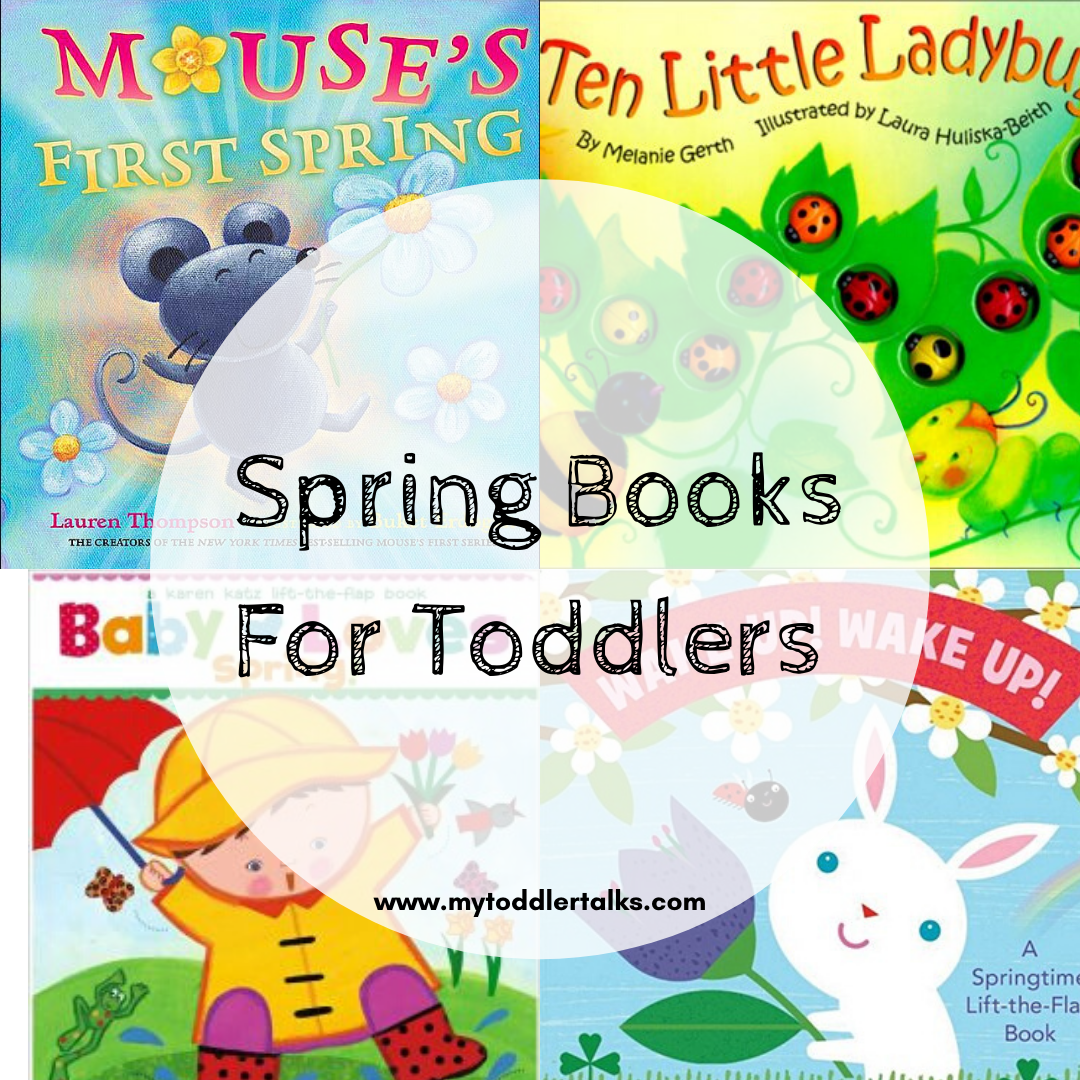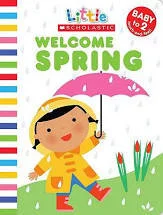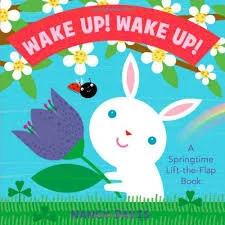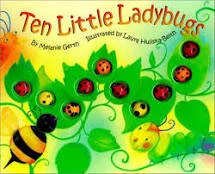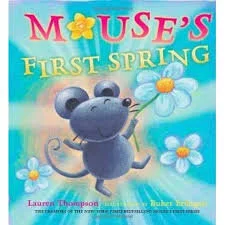5 Spring Books for Toddlers
5 Spring Books for Toddlers
I don’t know about you, but I’m super excited for spring. Since it’s been a VERY long winter for many of us, I’ve decided to write a post on some of my favorite spring books for toddlers. Reading tips and extension activities are included.
This is a simple spring time book. Its illustrations are bright, clean and cheery. Since it’s a touch and feel book your toddler can interact with different textures like satin, felt, and some type of rubber like material. I particularly like how this book shows how a young child experiences spring through her senses because it makes it easy to target verbs like smell, touch, hear, and see.
Since it’s a fairly basic book and the lines are short, it’s perfect for a younger toddler whose attention span may be shorter. Although the norms vary, toddlers between the ages of 16 and 19 months typically have an attention span that lasts 2 -3 minutes, toddlers aged 20 to 24 months can attend for about 3 to 6 minutes, and those 25 to 36 months old can focus on one thing for about 5 to 8 minutes.
Reading Tip:
Act out the senses! On the first page, there’s a picture of a young girl smelling flowers growing in the yard. After reading the line “Smell the flowers growing in the yard.” Pretend to smell the flower on the page. Then, encourage your child to smell the flower on the page. If you want to take it a step further, so you actually smell something, you could sprinkle the satin flower in the book with a hypoallergenic, non-toxic perfume, body oil, a scented spray etc.
Extension Tip:
Take the book with you and go outside on a nature walk. Smell the flowers in your garden (if you have any yet!) and listen to the birds chirping (place your hand to your ear and encourage your toddler to do the same). Before toddlers imitate speech, they try to imitate gestures and body movements. Performing these actions is a precursor to verbal imitation.
Baby Loves Spring! byKaren Katz
Who doesn’t love a little Karen Katz? In Katz’ classic child-like and folksy artistic style, she captures a child’s innate curiosity by having them reveal the answers to straightforward what questions under large flaps in the book.
Reading Tip:
Katz uses some lively verbs like tweeting, squiggling, and fluttering. They can easily be acted out like in the same way as explained in reading tip above. Or, after your child becomes familiar with the book, try having your toddler respond to the What questions – by giving a sign or saying a sound, word, or phrase. Or, focus on the springtime clothes the baby is wearing (hat, jacket (or raincoat), boots (or goulashes – challenge word!) and umbrella.
Extension Tip:
It rains a lot in the spring. Here in the Garden State, we average about 4.13 inches of rain per spring so we’re pretty familiar with umbrellas, raincoats, and goulashes. If it’s drizzling or raining lightly dress your toddler in his or her raingear and head outside. Jump in puddles, pop open an umbrella, find worms, feel raindrops fall into your hands, etc. Remember toddlers learn from hands on experience. FYI - Please use common sense and do not bring your child out if he is sick or ill. I do not want your child to get sick!
Check out my book companion that is loaded with fun activities to introduce your toddler to spring related vocabulary:
This is a cute lift the flap book. A friendly little ladybug wakes up from a long winter’s nap and realizes that it’s springtime. She then wakes up all her little friends including a bunny, a chick, a butterfly, and a tulip. The ladybug repeats the phrase, “Wake up! Wake up!” and proceeds to tell her friends that “The snow has melted, the sun is shining, and the flowers are blooming.” Repetition is important to toddlers and helps with language development; there’s a fair amount of it in this book.
Reading Tip:
If your toddler is starting to imitate sounds or words, encourage him or her to imitate the phrase “Wake up” BEFORE lifting the flap. Sometimes toddlers need a little (repeat LITTLE) pressure to increase verbal output. Prompt your toddler to say “wake up” while holding the flap down with your finger. If he or she understands a little sequencing and cause and effect you could tell him or her, “First say wake up and then lift the flap.” That seems to work for my own daughter. For more information on how to appropriately prompt a child to use words, please see technique 8 - Strategically prompt for target words in my book, My Toddler’s First Words.
Extension Tip:
If your toddler has any stuffed animals like those in the book, pretend they are sleeping and then wake them up with a gentle pat or shake while saying “Wake up”.
I’ll be honest, when I first bought this book at a garage sale many moons ago, I didn’t really like it. In fact, it sat in my basement collecting dust for a few years. Then, I had K and took it out to try sometime around her 1st birthday. Guess what? She loved it! She enjoyed labeling the softly painted bugs and animals, touching the plastic 3d ladybugs, pointing to the numbers, and listening to the rhythmic repetitive lines. Gerth was clearly thinking of the adult reader in mind when writing this story as well. It starts with ten little ladybugs sitting on a vine. Then as larger animals and bugs approach, the number of ladybugs gradually dwindle to one (gee, I wonder why?).Finally, they all magically reappear on the last page and live happily ever after with the larger animals and bugs. My daughter nor have any of the toddlers I read this book to have ever asked what happened to the ladybugs in between, so I don’t think you have to worry about explaining that to your toddler.
Reading Tip:
Sing this book! Even though I don’t directly focus on counting, it’s fun to put your fingers up and count as you sing the lines in this book. Once your child becomes familiar with the book you could sing the lines up to the point when a larger animal or bug enter the story. For instance, when reading “Ten little ladybugs sitting on a vine. Along came a ______” (Pause, wait expectantly, point to the picture of the animal or bug and see if you toddler will attempt to say it). I have many examples like this inMy Toddler Talks: Strategies and Activities to Promote Your Child's Language Development. It tends to work best with toddlers who have started talking, are familiar with the phrase and are imitating words.
Extension Tip:
Color some pictures of ladybugs, bumblebees, fish, frogs, and more bugs and animals!
If you have an older child who is working on saying the “l” sound you can also use this book along with my “L” sound articulation and puzzle cards!!
This is the longest book of the 5 and probably best suited for an older toddler or one who has stronger attention skills. A mouse and his mommy go outside to discover that spring has sprung. The lines are longer and the vocabulary is very descriptive and playful (e.g. glittery and flittery, fluttery and buttery) and there’s lots of onomatopoeia and repetitive lines (“What can it be wondered Mouse?”). If you’ve read any of the books in the Mouse’s First series, you’ll be familiar with author, Lauren Thompson’s style and format.
Reading Tip:
I like to scratch my head or rub my chin when reading the line “What can it be wondered Mouse?” My toddlers usually laugh, try gesturing themselves and or answer the question by pointing to the picture or naming the revealed insect or animal. Since this book is good for toddlers who are starting to combine words, you can work on extending and expanding their two word combinations by using expansions and extensions. These tips are included in My Toddler Talks, but click here if you’re interested in learning more. Since there are many prepositional phrases throughout the book (in the grass, on a stem, under a leaf), you can also work on your toddler's ability to follow simple commands related to the prepositions in, on, and under.
Extension Tip:
Typically, between the ages of 25 and 36 months old, toddlers begin saying several different prepositions. If your toddler is not, try increasing their understanding of the words by following directions and or locating objects. This is because toddlers need to understand words or concepts BEFORE they can start saying them. Remember understanding comes before production. Go outside with a few of your toddler's toy animals, perhaps those that are featured in Thompson's book and hide them (don't make it too hard though!). Encourage them to find them by giving directions using the prepositions in, on, under, etc. If your toddler struggles with this task, then show them where it is while saying the prepositional phrase ("It's on the deck, Sam" or "It's in the flower pot").
As always, I hope you found this post helpful. Does your toddler have a favorite spring time book? If so, please include in the comments.
If you’re in need of some more tips, spring time books or activities please read:
Spring Flowers: Arts and Crafts Activity for Toddlers and Preschoolers
5 Preschool Books for Spring with Reading Tips and Extension Activities
Baby Loves Spring Book Companion for Toddlers and Preschoolers
Happy reading!
In need of some additional free and helpful resources? Please subscribe to my newsletter. I share information and handouts exclusively with my newsletter subscribers.
If you have enjoyed reading My Toddler talks, please help spread the word. Tell your friends, write an honest review on Amazon, click the social media buttons or personally give me your feedback. I love hearing from my readers and value your input. YOU are the reason why I devote so much time to perfecting my craft. Thank you.
